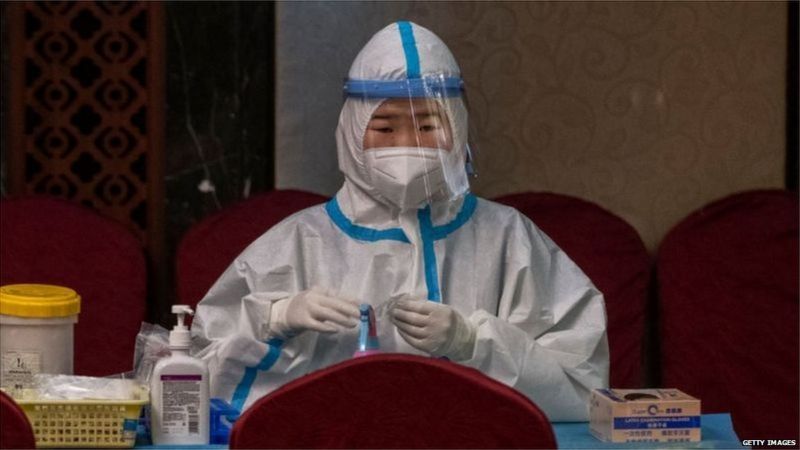

A WHO team went on a visit to China to investigate it. In the report of the investigation team, some important things have been told about the corona virus epidemic.
WHO Director General Dr. Tedros Adhanom Gebreyesus said, “This report is a very good beginning but it is not the end.” We have not yet received the source of the virus. “
This document has been prepared after examining 17 experts from China and a group of 17 international experts.
The investigation team reached China in late January this year where they visited hospitals, markets and laboratories for 14 days.
They gathered official data, reviewed studies from other countries, and analyzed samples taken from supply farms in markets in South China.
However, this investigation was carried out under the strict control of the local authority, who initially opposed it.
Four conclusions about the origin of the virus
The 120-page report outlines four possibilities regarding the origin of the virus and its spread to humans.
Based on the evidence found here, experts have concluded:
1. The human animal viruses reach potential
According to the report, there is strong evidence that many corona viruses that have reached humans have originated from fauna.
According to the document, the organism from which this virus has arrived in humans can be bats. Bats are included in animals that contain many viruses that can spread to humans.
The report also raises the possibility that pangolins or minks may also be animals that have infected humans.
2. The possibility of another animal being in the middle of spreading the infection from animal to humans.
This possibility says that the animal which has corona for the first time has infected any other animal before humans. Humans have been infected by that other infected animal again.
This is based on the fact that there are some differences in many viruses related to the SARS-Covid-2 found in bats, suggesting that there is a ‘missing link’ in between.
This missing link can be an animal that has come in contact with both the animal and human being infected for the first time.
The document mentions that a growing number of animals susceptible to SARS-Covid-2 also include wild animals that are reared for farming.
According to the researchers, “This possibility leads to a kink which is difficult to solve.”
3. Possibility of reaching humans with food items
This hypothesis states that the Covid-19 virus has reached humans through food items or containers containing them.
This includes frozen foods that are commonly sold in Wuhan markets.
There is evidence for the possibility that SARS Covid-2 may persist in infected Frozen products. In recent times, this has also been repeatedly emphasized in the official media of China. He refers to the goods coming from abroad.
However, the WHO document states that there is no conclusive evidence of transmission of the SARS covid-2 virus and that the virus is also less likely to spread through the cold chain.
4. Less likely for the virus to spread from laboratory to humans
There is a possibility that the virus spread to the personnel there due to an accident in the laboratory.
The document makes it clear that they did not analyze the possibility that someone had spread the virus intentionally.
They have not even inquired about whether the virus was produced in the laboratory, because this possibility has already been rejected by other scientists based on analysis of the virus genome.
The report acknowledges that such accidents are rare in laboratories but, they can happen.
The document states, “Humans may be infected in laboratories due to limited safety or carelessness during growth of the virus, vaccination in animals or working with clinical samples.”
However, the report states that “no laboratory records of genomes that make up the SARS-COVID-2 genome from SARS-COVID-2-related viruses or combinations have been found in any laboratory prior to December 2019”.
According to the WHO, the three Wuhan laboratories working on the corono virus have “high-quality biosafety levels”. Here not a single employee has found any disease related to Covid-19 months or weeks before December 2019.
However, Tedros Adhanom has said that more data and studies are needed to reach more concrete conclusions about the spread of the virus from the laboratory.
He added, “However, the team has concluded that there is little chance of the virus leaking from the laboratory. More investigation needs to be done in this regard. “
Despite all these possibilities about the origin of the virus, there are some questions that remain unresolved.
1. Wuhan market
The initial cases of Covid-19 were related to Hunan Bazaar in the Chinese city of Wuhan.
From the beginning of the epidemic, Wuhan was seen as a source of the corona virus.
However, the investigation states that “there is no evidence to conclude” that the place has a role in the genesis of the epidemic.
The document says that although the initial cases are related to the Hunan market, similar cases have been reported in other markets as well. Many other matters are not even related to markets.
The team confirmed that there was widespread infection of SARS-Covid-2 in the Hunan market in Wuhan but its source could not be ascertained.
The report states, “This suggests that Hunan’s market is not the real source of this epidemic.”
2. Cultivation in other countries
Research also suggests that the virus may have arrived in Wuhan’s market from farms where the market is supplied and Sars-Covid-2 is found in large quantities in bats there.
However, the document also states that it does not show any link but creates another possibility for investigation.
When the first outbreak of the corona virus was detected, animal products were coming to the Hunan market from 20 countries, including some in which SARS-Covid-2 cases were reported at the end of 2019.
In this research, one of the representatives of WHO, Peter Daszack, says that farming animals are the most likely source of the onset of the epidemic in Southeast Asia.
Daszac said in an NPR report that these farms could be places where coronovirus would have reached another animal and then its people from a bat.
Tedros Adhanom said, “More studies will have to be done to find out what role farming animals may have played in transmitting the virus to markets in Wuhan and elsewhere.”
3. First case of infection
The report also states that the SARS-Covid-2 virus was spreading for several weeks before it was detected in humans.
The team reviewed published studies in several countries indicating early spread of the virus.
The report said that many samples were found positive even before the first case came to Wuhan. This suggests that the virus may have been spreading to other countries as well.
Researchers warn that “the quality of the study is limited” but it is important to investigate potential cases before infection.
Members of the China Mission have recommended more testing on wildlife and livestock in China and Southeast Asia, more studies on earlier cases of C
ovid-19, and tracing supply chains from markets in Wuhan.
Despite the progress of this research, the WHO director has said, “It takes time to trace the origin of the virus. A trip to investigate cannot answer all the questions.”
Also Read: FROM TOMORROW, PEOPLE ABOVE 45 YEARS OF AGE WILL GET CORONA VACCINE







